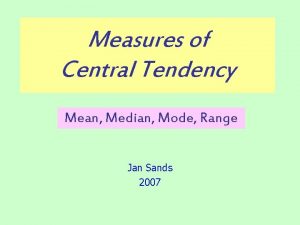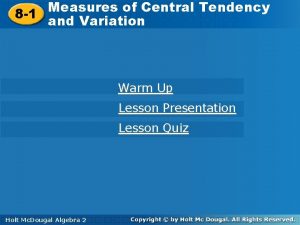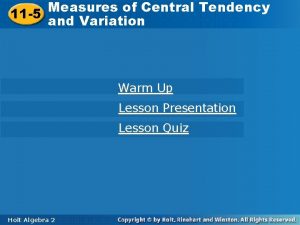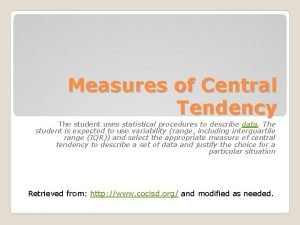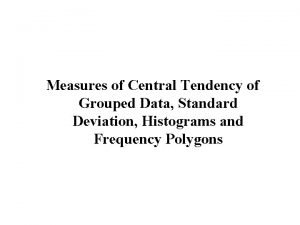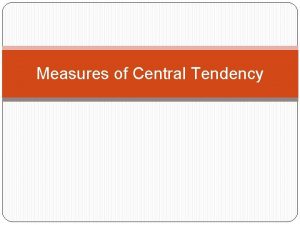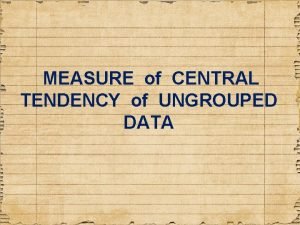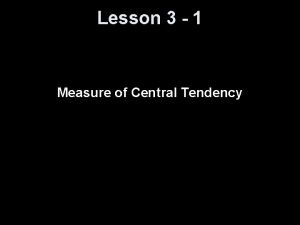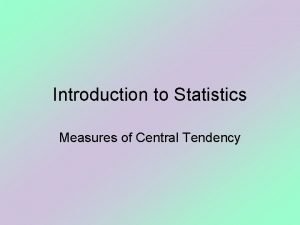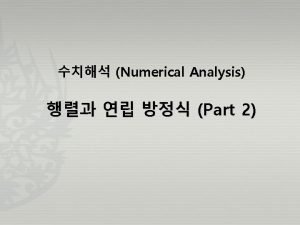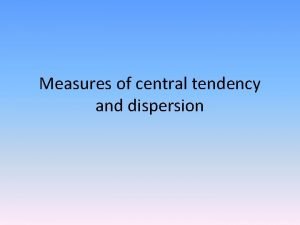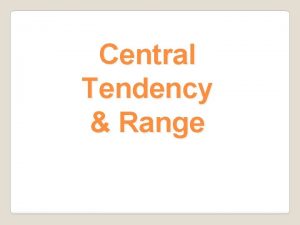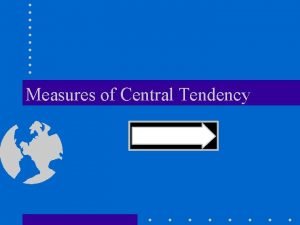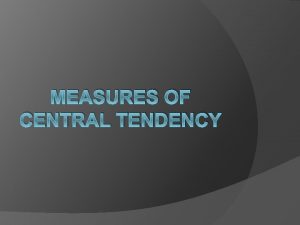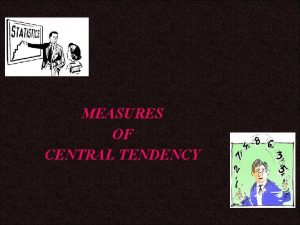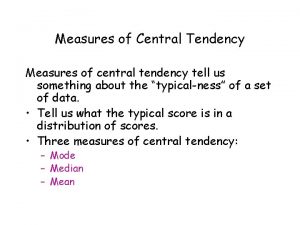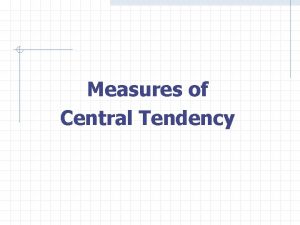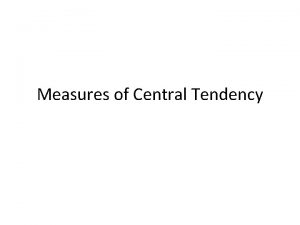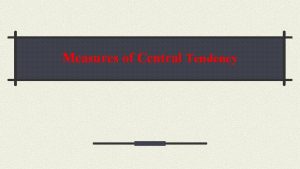Range and Measures of Central Tendency Range and











- Slides: 11

Range and Measures of Central Tendency Range and measures of central tendency (mean, median and mode) are values that summarize a set of data. They are useful when analyzing data.

Range the difference between the greatest and the least values in a data set Daily High Temperatures (for any given date) Over the Last Decade 1993 1994 1995 1996 1997 1998 1999 2000 2001 2002 59 50 49 13 40 46 50 53 58 47 To find the range of the daily high temperatures, subtract the least value from the greatest value. 59° - 13° = 46°

Mean (or average) the sum of a set of data divided by the number of data Daily High Temperatures (for any given date) Over the Last Decade 1993 1994 1995 1996 1997 1998 1999 2000 2001 2002 59 50 49 13 40 46 50 53 58 47 To find the mean, find the sum of the data 59+50+50+13+40+46+50+53+58+57=465 and divide it by the number of data. 465÷ 10=46. 5 The mean for daily high temperature over the last decade is 46. 5°, or approximately 47°.

Median the middle value of a data set Daily High Temperatures (for any given date) Over the Last Decade 1993 1994 1995 1996 1997 1998 1999 2000 2001 2002 59 50 49 13 40 46 50 53 58 47 To find the median, place all the data in numerical order, then find the middle number. If there are two middle numbers, find the mean (or average) of the two middle numbers. 13 40 46 47 49 50 50 53 58 59 49+50=99 99÷ 2=49. 5

Mode the most common value in a data set Daily High Temperatures (for any given date) Over the Last Decade 1993 1994 1995 1996 1997 1998 1999 2000 2001 2002 59 50 49 13 40 46 50 53 58 47 To find the mode, find the most common value. It helps to place data in numerical order to find the mode. 13 40 46 47 49 50 50 53 58 59 If there is not a value which appears more often than another, then there is no mode.

Outliers Sometimes there are extreme values that are separated from the rest of the data. These extreme values are called outliers. Outliers affect the mean. Daily High Temperatures (for any given date) Over the Last Decade 1993 1994 1995 1996 1997 1998 1999 2000 2001 2002 59 50 49 13 40 46 50 53 58 47 The daily high temperature in 1996 is the outlier. Mean 59+50+49+13+40+46+50+53+58+57=494 465÷ 10=46. 5

Because outliers can affect the mean, the median may be better measures of central tendency. You might consider the median to best represent the expected temperature. Median 13 40 46 47 49 50 50 53 58 59 49+50=99 99÷ 2=49. 5

Sometimes the mode is more helpful when analyzing data. If you were trying to determine what clothes to wear for a day trip, you might base your decision on the mode temperature because the mode temperature is the temperature which occurred most often. 13° 40° 46° 47° 49° 50° 53° 58° 59°

Dropping the outlier may help when determining the mean. 59+50+49+13+40+46+50+53+58+57=494 465÷ 10=46. 5° 40+46+47+49+50+50+53+58+59=452 452÷ 9=50. 2° When the 13° outlier is dropped, the average daily temperature increases by more than 4° to 50. 2°, which is closer to both the median of 49. 5° and the mode of 50°.

You Try It! Jessica’s test scores in Algebra for the first semester are 93, 79, 88, 77, 92, 88, 80, 34, 88. Calculate the range, mean, median, and mode. Then make and explain a prediction for next semester’s test scores. Range: 59 Median: 86 Mean: 80. 3 Mode: 88 Predictions will vary: Jessica will score an estimated average of 85 on her tests. I determined this by removing the outlying score of 34 and recalculated the mean.

Presentation developed by W. D. Martin © 2003 www. beaconlearningcenter. com Rev. 12. 14. 03
 Range in central tendency
Range in central tendency Purpose of measures of central tendency
Purpose of measures of central tendency Measures of central tendency and variation
Measures of central tendency and variation Measures of central tendency
Measures of central tendency Measures of central location for grouped data
Measures of central location for grouped data Objective of central tendency
Objective of central tendency Central tendency symbols
Central tendency symbols Objectives of measures of central tendency
Objectives of measures of central tendency Measures of central tendency
Measures of central tendency Mode calculation for grouped data
Mode calculation for grouped data Measures of central tendency
Measures of central tendency Measure of central tendency and dispersion
Measure of central tendency and dispersion
